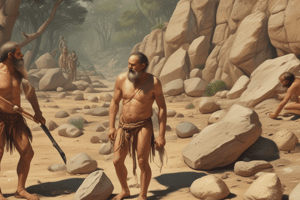Podcast
Questions and Answers
What is the primary reason for the invention of Oldowan tools?
What is the primary reason for the invention of Oldowan tools?
- To create art
- To generate heat
- To access new sources of food (correct)
- To build shelters
Where were Oldowan tools first identified and studied?
Where were Oldowan tools first identified and studied?
- Olduvai Gorge, Tanzania (correct)
- Rift Valley, Kenya
- Cradle of Humankind, South Africa
- Afar Triangle, Ethiopia
How long did the use of Oldowan tools span in terms of years?
How long did the use of Oldowan tools span in terms of years?
- 2.9 million years
- 1.2 thousand years
- 1.2 billion years
- 1.2 million years (correct)
Which types of rocks were primarily used to create Oldowan tools?
Which types of rocks were primarily used to create Oldowan tools?
Which hominin is associated with the discovery of Oldowan tools alongside its fossils?
Which hominin is associated with the discovery of Oldowan tools alongside its fossils?
Which feature characterizes robust australopithecines like Paranthropus robustus?
Which feature characterizes robust australopithecines like Paranthropus robustus?
What striking technique was primarily used to create Oldowan tools?
What striking technique was primarily used to create Oldowan tools?
What has recent archaeological discovery suggested about the use of tools?
What has recent archaeological discovery suggested about the use of tools?
How did early Oldowan tool-makers achieve sharp flakes?
How did early Oldowan tool-makers achieve sharp flakes?
Which period did the Oldowan tools primarily belong to?
Which period did the Oldowan tools primarily belong to?
What was the significance of the DNH 155 cranium discovered in 2021?
What was the significance of the DNH 155 cranium discovered in 2021?
How did Paranthropus robustus differ from Homo erectus?
How did Paranthropus robustus differ from Homo erectus?
Who initially described the species Paranthropus robustus?
Who initially described the species Paranthropus robustus?
What was revealed by comparing the DNH 155 cranium with other fossils?
What was revealed by comparing the DNH 155 cranium with other fossils?
When did Paranthropus robustus first appear on the landscape?
When did Paranthropus robustus first appear on the landscape?
What type of evolutionary pattern does Paranthropus robustus represent?
What type of evolutionary pattern does Paranthropus robustus represent?
Where were the remains of Paranthropus robustus first discovered?
Where were the remains of Paranthropus robustus first discovered?
What feature of Homo erectus differentiates it from Paranthropus robustus?
What feature of Homo erectus differentiates it from Paranthropus robustus?
What geological age is attributed to the DNH 155 cranium?
What geological age is attributed to the DNH 155 cranium?
What was the connection between the DNH 155 cranium and climate change?
What was the connection between the DNH 155 cranium and climate change?
What major evolutionary benefit did Oldowan tools provide to early hominins?
What major evolutionary benefit did Oldowan tools provide to early hominins?
What was the main characteristic of the stone tools known as the Oldowan toolkit?
What was the main characteristic of the stone tools known as the Oldowan toolkit?
Which method was used by early tool-making hominins to produce sharp flakes?
Which method was used by early tool-making hominins to produce sharp flakes?
Which hominin was discovered alongside the oldest known distinctive stone tools in Kenya?
Which hominin was discovered alongside the oldest known distinctive stone tools in Kenya?
What aspect of the Oldowan industry's geographical origin is significant?
What aspect of the Oldowan industry's geographical origin is significant?
What might have contributed to the development of Oldowan tools according to the information provided?
What might have contributed to the development of Oldowan tools according to the information provided?
How did the characteristics of robust australopithecines, like Paranthropus robustus, differ from gracile australopithecines?
How did the characteristics of robust australopithecines, like Paranthropus robustus, differ from gracile australopithecines?
What striking feature about the 2023 archaeological finds in Kenya challenges previous assumptions?
What striking feature about the 2023 archaeological finds in Kenya challenges previous assumptions?
What does the presence of inflated cheek teeth in robust australopithecines suggest?
What does the presence of inflated cheek teeth in robust australopithecines suggest?
Who discovered the first remains of Paranthropus robustus at the Kromdraai cave site?
Who discovered the first remains of Paranthropus robustus at the Kromdraai cave site?
What significant finding was made by Jesse Martin and Angeline Leece in 2021?
What significant finding was made by Jesse Martin and Angeline Leece in 2021?
What year was Paranthropus robustus first described?
What year was Paranthropus robustus first described?
Which characteristic distinguishes Paranthropus robustus from Homo erectus?
Which characteristic distinguishes Paranthropus robustus from Homo erectus?
What is one implication of the comparison of the DNH 155 cranium to other fossils?
What is one implication of the comparison of the DNH 155 cranium to other fossils?
What is the estimated age of the DNH 155 cranium?
What is the estimated age of the DNH 155 cranium?
How did Paranthropus robustus and Homo erectus coexist in terms of evolution?
How did Paranthropus robustus and Homo erectus coexist in terms of evolution?
What crucial role did climate change play regarding the fossils found in the cradle of civilization?
What crucial role did climate change play regarding the fossils found in the cradle of civilization?
What kind of evidence does the DNH 155 cranium provide regarding human evolution?
What kind of evidence does the DNH 155 cranium provide regarding human evolution?
What relationship does Paranthropus robustus have with Homo sapiens?
What relationship does Paranthropus robustus have with Homo sapiens?
What discovery made by Jesse Martin and Angeline Leece in 2021 holds significant importance in understanding Paranthropus robustus?
What discovery made by Jesse Martin and Angeline Leece in 2021 holds significant importance in understanding Paranthropus robustus?
What evolutionary significance does the coexistence of Paranthropus robustus and Homo erectus suggest?
What evolutionary significance does the coexistence of Paranthropus robustus and Homo erectus suggest?
How does the discovery of the DNH 155 cranium contribute to our understanding of human evolution?
How does the discovery of the DNH 155 cranium contribute to our understanding of human evolution?
What primary feature distinguishes Paranthropus robustus from its contemporary, Homo erectus?
What primary feature distinguishes Paranthropus robustus from its contemporary, Homo erectus?
What is a notable characteristic of Paranthropus robustus's teeth compared to those of Homo erectus?
What is a notable characteristic of Paranthropus robustus's teeth compared to those of Homo erectus?
What does the time frame of around 2 million years ago indicate about Paranthropus robustus in relation to Homo erectus?
What does the time frame of around 2 million years ago indicate about Paranthropus robustus in relation to Homo erectus?
Which of the following statements about the classification debates regarding Paranthropus robustus is accurate?
Which of the following statements about the classification debates regarding Paranthropus robustus is accurate?
What role does climate change play concerning the evolutionary findings associated with Paranthropus robustus?
What role does climate change play concerning the evolutionary findings associated with Paranthropus robustus?
Which of the following findings is emphasized by the DNH 155 cranium being the best-preserved representative of Paranthropus robustus?
Which of the following findings is emphasized by the DNH 155 cranium being the best-preserved representative of Paranthropus robustus?
What indicates that Paranthropus robustus may not have needed tools for processing food?
What indicates that Paranthropus robustus may not have needed tools for processing food?
Which characteristic of Oldowan tools made them evolutionary advantageous for early hominins?
Which characteristic of Oldowan tools made them evolutionary advantageous for early hominins?
What does the discovery of stone tools alongside Paranthropus fossils suggest about tool use?
What does the discovery of stone tools alongside Paranthropus fossils suggest about tool use?
What can be inferred about the impact of Oldowan tools on ancient Hominins?
What can be inferred about the impact of Oldowan tools on ancient Hominins?
Which factor is NOT associated with the technical creation of Oldowan tools?
Which factor is NOT associated with the technical creation of Oldowan tools?
What distinguishes Oldowan tools from later stone tools in their evolution?
What distinguishes Oldowan tools from later stone tools in their evolution?
What role did the geographical area of East Africa play in the development of early tool technologies?
What role did the geographical area of East Africa play in the development of early tool technologies?
How do inflation in cheek teeth correlate with the dietary habits of robust australopithecines like Paranthropus robustus?
How do inflation in cheek teeth correlate with the dietary habits of robust australopithecines like Paranthropus robustus?
What implication does the significant age of the recent Kenyan find have on the understanding of hominin evolution?
What implication does the significant age of the recent Kenyan find have on the understanding of hominin evolution?
What does the term 'least-effort flaking strategies' imply in the context of Oldowan tool production?
What does the term 'least-effort flaking strategies' imply in the context of Oldowan tool production?
Flashcards are hidden until you start studying
Study Notes
Oldowan Tool Kit
- Simple stone tools, typically one or a few flakes chipped off a core stone.
- Used during the Lower Paleolithic period (2.9 - 1.7 million years ago).
- Found across much of Africa, providing early hominins with evolutionary advantages in food access and raw material processing.
- Named after Olduvai Gorge in Tanzania, a significant site for paleoanthropological discoveries.
- 2023 discovery in Kenya suggests tools may be up to 3 million years old, potentially the oldest known.
- Tools found alongside Paranthropus fossils challenge the assumption that only Homo species used stone tools.
- Tools were made using least-effort flaking strategies, utilizing fissile rocks like volcanic stones and quartzites.
Paranthropus robustus
- Robust australopithecine species from the Early and Middle Pleistocene of South Africa (2.27 - 0.87 million years ago).
- Characterized by heavily built skulls, high bite forces, and inflated cheek teeth.
- First remains (partial skull and jawbone) discovered in 1938 at Kromdraai cave, South Africa.
- 2021 discovery of the DNH 155 cranium in Drimolen Cave, South Africa, dated to 2 million years old – the oldest, best-preserved specimen.
- Extinct 1 to 1.4 million years ago.
- Considered a cousin of Homo sapiens, not a direct ancestor.
- Co-existed with Homo erectus around 2 million years ago, representing divergent evolutionary paths.
- DNH 155 cranium provides evidence of microevolutionary change in Paranthropus robustus over a short time and limited geographic area, potentially due to climate change.
Oldowan Tool Kit
- Oldowan tools (Mode I), simple stone tools made with flakes chipped off a core, were used in the Lower Paleolithic (2.9-1.7 million years ago) across Africa.
- These tools, though crude, offered significant evolutionary advantages, providing access to new food sources and allowing processing of other materials.
- The Oldowan industry's name comes from Olduvai Gorge in Tanzania, where many artifacts and fossils were discovered by the Leakeys.
- A 2023 discovery in Kenya revealed Oldowan tools potentially dating back 3 million years, the oldest yet found.
- These tools were found alongside Paranthropus fossils, suggesting tool use wasn't exclusive to Homo ancestors.
- Oldowan toolmaking involved hitting a fissile core (e.g., volcanic stone, quartzite) with a hammerstone to create sharp flakes.
Paranthropus robustus
- Paranthropus robustus, a robust australopithecine, lived in South Africa's Cradle of Humankind from 2.27 to 0.87 million years ago.
- Robust australopithecines are characterized by heavily built skulls, strong bite forces, and large cheek teeth.
- The first P. robustus remains (TM 1517) were discovered in 1938 at Kromdraai cave.
- In 2021, the DNH 155 cranium, a 2-million-year-old, well-preserved P. robustus skull, was found in Drimolen Cave, South Africa.
- P. robustus went extinct 1-1.4 million years ago; it's considered a cousin of Homo sapiens, not a direct ancestor.
- P. robustus coexisted with Homo erectus around 2 million years ago, representing divergent evolutionary paths.
- The DNH 155 cranium provides evidence of microevolutionary changes in P. robustus over a short timescale and limited geographic area, potentially due to climate change.
Oldowan Toolkit
- Simple stone tools, characterized by one or a few flakes chipped off a core stone.
- Used during the Lower Paleolithic period (2.9-1.7 million years ago).
- Found across Africa.
- Provided early hominins with evolutionary advantages, such as access to new food sources and processing of raw materials.
- Named after Olduvai Gorge in Tanzania, where many artifacts were discovered.
- Recently discovered tools in Kenya may be up to 3 million years old, the oldest found to date.
- Tools found alongside Paranthropus fossils, suggesting tool use wasn't exclusive to Homo.
- Makers utilized least-effort flaking strategies with fissile rocks (cores) like volcanic stones and quartzites, struck with hammerstones to create sharp flakes.
Paranthropus robustus
- Species of robust australopithecine from South Africa (Cradle of Humankind).
- Existed between 2.27 and 0.87 million years ago.
- Characterized by heavily built skulls, strong bite forces, and large cheek teeth.
- First remains (partial skull) discovered in 1938 at Kromdraai cave by Gert Terblanche.
- DNH 155 cranium, a 2-million-year-old specimen, is the oldest and best-preserved P. robustus fossil.
- Went extinct approximately 1-1.4 million years ago.
- Considered a cousin of Homo sapiens, not a direct ancestor.
- Coexisted with Homo erectus around 2 million years ago, showcasing divergent evolutionary paths.
- DNH 155 cranium provides evidence of microevolutionary change within the species over a short timescale, potentially due to climate change.
Studying That Suits You
Use AI to generate personalized quizzes and flashcards to suit your learning preferences.



